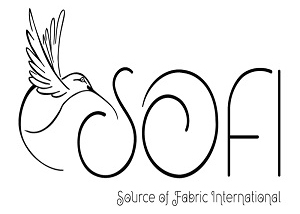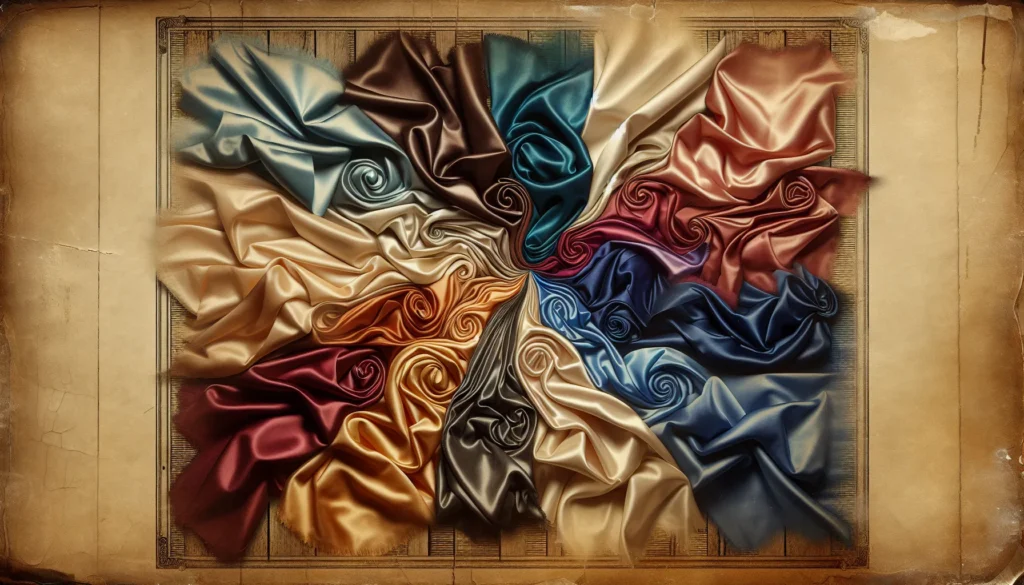Satin fabric is synonymous with luxury and elegance, making it a popular choice for everything from evening gowns to home decor. But did you know there are different types of satin, each with its unique characteristics? Understanding these variations can help you make informed choices for your next sewing or decorating project.
Whether you’re drawn to the glossy finish of silk satin or the durability of polyester satin, each type offers distinct benefits and uses. In this article, you’ll discover the various types of satin fabric, their features, and how to choose the right one for your needs. Dive in and explore the world of satin, where texture, shine, and versatility come together to elevate your creations.
Understanding Satin Fabric
Satin fabric stands out for its distinct smooth surface and glossy finish. This fabric type becomes popular for clothing and home decor because of its luxurious appearance and feel. Different satin types exist, each possessing unique properties that suit various applications.
What Is Satin?
Satin refers to a weave pattern rather than a specific fiber. This weave produces a glossy front with a dull back, creating a striking contrast. Materials like silk, polyester, and nylon commonly form satin. Silk satin demonstrates a soft and breathable quality, ideal for high-end garments. Polyester satin offers durability and affordability, making it a popular choice for dressmaking and upholstery. Nylon satin, known for its lightweight nature, suits items like sleepwear and lingerie. When evaluating satin options, consider factors like sheen, drape, and fiber content to find the best match for your projects.
History of Satin
Satin originated in China over a thousand years ago during the Tang Dynasty. Initially, only silk satin existed, reserved for the elite due to its labor-intensive production. As trade routes expanded, satin gained popularity in Europe, especially during the Middle Ages. By the 14th century, satin became a symbol of wealth among nobility. The invention of synthetic fibers in the 20th century revolutionized satin production, making it affordable and accessible to the masses. Today, satin remains a favorite in fashion and interior design, providing a classic charm that endures through time.
Types of Satin Fabric
Satin fabric comes in various types, each with unique features and purposes. Understanding these types helps in choosing the right satin for your projects.
Silk Satin
Silk Satin features a surface that is smooth and shiny, providing a luxurious feel. The fabric derives its softness and sheen from silk fibers, making it a top choice for high-end garments such as evening gowns, lingerie, and bridal wear. Silk satin drapes beautifully, allowing for stunning silhouettes and flow in clothing designs.
Weight varies within silk satin types, ranging from lightweight to medium weight, catering to different design needs. Lightweight silk satin suits flowing dresses, while medium-weight options offer sturdiness for structured garments.
Care instructions involve dry cleaning or gentle hand washing to maintain its properties. Avoiding excessive sunlight and harsh chemicals ensures the fabric remains vibrant and intact over time.
Uses extend beyond clothing. Designers select silk satin for unique home decor items like pillow covers, curtains, and tablecloths. The fabric’s soft touch enhances interior spaces, adding a hint of luxury.
Recommendations include testing a small swatch before undertaking larger projects. This approach confirms the appropriateness of the fabric for desired applications in both fashion and decor.
Polyester Satin
Polyester satin combines the soft, glossy appearance of traditional satin with the durability of polyester. This type of fabric stands out for its ease of care and affordability, making it suitable for a variety of projects.
Characteristics of Polyester Satin
Polyester satin possesses several notable features. Texture: The fabric has a smooth and shiny surface, which reflects light beautifully. Weight: It comes in various weights, suitable for different applications, from lightweight garments to heavier home décor items. Durability: Polyester satin is strong and resistant to wrinkles and shrinkage, offering longevity in wear. Breathability: Although slightly less breathable than silk satin, it still provides adequate ventilation for comfort. Cost: Polyester satin remains significantly more affordable compared to silk and other natural fibers, making it more accessible for large projects.
Advantages of Polyester Satin
Polyester satin offers multiple advantages. Affordability: This fabric provides high-end visual appeal at a lower cost than silk. Care: Polyester satin is machine washable and easy to care for, saving time and effort on maintenance. Versatility: You can use polyester satin for various applications, such as dresses, blouses, curtains, and pillow covers. Color Options: This fabric is available in a wide range of vibrant colors and patterns, enhancing creative possibilities. Stability: Polyester satin retains its shape and color well over time, even with frequent use.
Acetate Satin
Acetate satin offers a unique blend of qualities that appeal to many designers and consumers.
Characteristics of Acetate Satin
Acetate satin features a smooth, glossy surface that captures light beautifully. It displays a soft hand feel, making it comfortable against the skin. Acetate fibers come from natural sources, primarily wood pulp, allowing for a lightweight and flowing fabric. Acetate satin drapes exceptionally well, giving garments a beautiful silhouette. The fabric stands out with its ability to mimic the luxurious look of silk while being more affordable.
Acetate satin is less durable than polyester satin and may crease more easily. The fabric can fade with prolonged exposure to sunlight. The washability of acetate satin varies; many fabrics benefit from dry cleaning to maintain their quality.
Understanding these characteristics aids in determining the best applications for acetate satin in your projects.
Common Uses of Acetate Satin
Acetate satin is popular in evening wear, dresses, and blouses due to its beautiful drape and sheen. Designers often use it for runway collections and special occasion attire. The fabric’s affordability makes it a top choice for costume design and theatrical productions as well.
Beyond clothing, acetate satin finds purpose in home decor. It serves well in curtains and cushion covers, adding a touch of luxury to interiors without high costs.
Acetate satin also works in accessories like handbags and hair pieces, enhancing their visual appeal without sacrificing function. When selecting acetate satin, ensure it aligns with your project’s specific needs and desired aesthetics.
Nylon Satin
Nylon satin combines the smooth properties of satin with the strength of nylon. This fabric provides a shiny, polished look, making it appealing for various applications.
Characteristics of Nylon Satin
Nylon satin features a soft and smooth texture. The glossy surface reflects light beautifully, offering a striking appearance. This fabric is lightweight and often used in garments and accessories where drape and flow matter. Nylon satin is resistant to wrinkling and fraying. Its durability ensures it withstands wear and tear. Additionally, the fabric has a breathable quality, making it comfortable for extended wear. Nylon satin also accepts dyes well, allowing for rich and vibrant colors. This versatility adds to its popularity in fashion and home decor. It is commonly available in various weights, catering to different design needs.
Benefits of Nylon Satin
Nylon satin provides multiple benefits essential for designers and consumers alike. The fabric’s durability makes it ideal for high-use items such as clothing and accessories. Its resistance to wrinkles translates to easy maintenance, reducing time spent on upkeep. The lightweight nature of nylon satin enhances comfort, especially in layering pieces. This fabric drapes beautifully, making it suitable for flowing dresses and skirts.
Affordability also represents a key advantage of nylon satin. It offers a luxurious appearance without the high cost associated with silk or other premium fabrics. The ease of care increases its desirability. Being machine washable often contributes to its appeal. Nylon satin’s versatility allows it to be used in both casual and formal designs, making it suitable for various occasions. Finally, its vibrant color options enhance creative possibilities, allowing you to experiment with different looks and styles.
Rayon Satin
Rayon satin offers a blend of silk-like sheen and softness, making it a popular fabric choice for various applications. This material is known for its ability to drape beautifully, providing an appealing look for both clothing and home decor.
Characteristics of Rayon Satin
Rayon satin features a smooth texture and vibrant colors that enhance its visual appeal. Its luster rivals that of silk satin while being more affordable. The fabric is lightweight and breathable, making it suitable for warm-weather garments. Rayon satin drapes well, creating flattering silhouettes that cling softly to the body. The fabric’s soft hand feel adds comfort, making it pleasant to wear against the skin.
Rayon satin is also known for its absorbent properties, allowing it to retain dyes effectively and resulting in bold colors. However, it may wrinkle easily and requires careful handling during washing and drying. The fabric can be prone to fading, especially when exposed to sunlight. When looking for options, select high-quality rayon satin to ensure durability and maintain its beautiful appearance.
Common Uses of Rayon Satin
Rayon satin is widely used in fashion for various garments. This fabric is a favored choice for dresses, blouses, and skirts, providing a luxurious feel without the high cost of silk. It works well for evening wear, where the glossy finish creates an eye-catching appearance. Designers often choose rayon satin for flowing gowns and stylish active wear due to its movement and draping capabilities.
In addition to clothing, rayon satin finds applications in home decor. The fabric is suitable for curtains, pillow covers, and table linens, adding a touch of sophistication to interiors. Its vibrant colors and soft texture make it appealing for decorative items, enhancing overall aesthetics in living spaces. Moreover, rayon satin is popular for creating accessories such as scarves, bags, and headbands, allowing for a blend of style and practicality.
Choosing the Right Type of Satin Fabric
Choosing the right type of satin fabric involves understanding the specific qualities each variety offers. Each type serves different purposes based on texture, durability, and application.
Considerations for Selection
When selecting satin, consider these key factors:
- Project Type: Identify the end use of your project. For formal wear, silk satin provides a luxurious finish. For everyday items, polyester satin offers durability and affordability.
- Weight: Assess the weight of the fabric. Lightweight satin works well for flowing dresses while heavier satin is ideal for structured garments.
- Care Requirements: Evaluate how much maintenance you can commit to. Silk and acetate satin often require dry cleaning to maintain their appearance while polyester and nylon satin can withstand regular washing.
- Cost: Determine your budget. Options like polyester and acetate satin tend to be more wallet-friendly, while silk satin, although pricier, provides a premium look.
- Color and Texture: Choose the color and texture based on your design vision. Satin fabrics offer a variety of vibrant hues and finishes, impacting the overall aesthetic of your project.
Tips for Matching Satin with Projects
Matching satin fabric to your project enhances the final outcome. Follow these tips:
- Design Needs: Align the satin type with your design. For formal dresses, consider using silk or rayon satin for their draping abilities. For costumes, polyester or acetate satin suits the budget without compromising style.
- Seasonality: Factor in the season. Lightweight fabrics are ideal for summer garments while heavier options are suitable for fall or winter attire.
- End Use: Think about how the item will be used. Activewear benefits from nylon satin, known for its resilience, while home decor items like curtains can use silk or polyester satin for their aesthetic appeal.
- Draping Effects: Experiment with draping. Silk and rayon satin create soft and flowing lines while polyester satin provides structure. Test swatches to see how each type moves and feels.
- Intended Longevity: Consider how long the item needs to last. For pieces meant for multiple wears, nylon or polyester satin offers the durability required, while silk is better reserved for occasion wear.
By carefully considering your project needs and how each satin type aligns with them, you can achieve the desired results with your fabric choices.
Caring for Satin Fabric
Caring for satin fabric requires specific techniques to maintain its appearance and longevity. Proper care ensures that the fabric retains its luxurious look while preventing damage.
Washing and Drying Satin
Washing satin fabric involves gentle methods. For handwashing, use cool water and a mild detergent designed for delicate fabrics. Submerge the fabric lightly and agitate gently for a few minutes. Avoid twisting or wringing, as this can damage the fibers. Rinse thoroughly under cool water until the detergent is completely removed.
If machine washing is necessary, place satin items in a mesh laundry bag to protect them. Use the delicate cycle with cold water and a mild detergent. Avoid bleach or fabric softeners, as these can harm the fabric.
Drying satin requires care. Air drying is recommended to avoid the heat damage caused by dryers. Lay the fabric flat on a clean, dry towel or hang it on a padded hanger in a shaded area. If drying in direct sunlight, know that prolonged exposure can fade colors.
For satin items with embellishments, consider dry cleaning as the safest option to maintain their quality. Following these washing and drying strategies keeps satin looking fresh and vibrant.
Ironing Tips for Satin
Ironing satin fabric necessitates caution. Use a low-temperature setting on your iron. High heat can scorch satin, so always ensure the iron is not too hot.
Ironing from the reverse side prevents shine. Place a clean cloth or pressing cloth between the iron and the satin to shield it from direct heat. This approach protects the fabric while still allowing for smooth results.
If you encounter stubborn wrinkles, steam can help. Hang the garment in a bathroom while running a hot shower or use a handheld steamer to remove wrinkles without direct contact with the iron.
Always test a small, inconspicuous area first. This confirms that your methods do not damage the fabric. Your careful approach when ironing satin keeps the fabric looking pristine and ready for wear.
Troubleshooting Common Issues with Satin Fabric
Satin fabric can present some challenges during use and care. Understanding these common issues can help you maintain the look and feel of your satin items.
Dealing with Wrinkles
Wrinkles can appear in satin fabric after storage or washing. To remove wrinkles, use these methods:
- Steam: Hang your satin garment and use a handheld steamer about 6 inches away to safely release wrinkles without direct contact.
- Ironing: Set your iron to the lowest heat setting suitable for satin. Place a thin cloth over the satin while ironing to prevent direct contact, which can cause shine or damage.
- Damp Cloth: Lightly mist the satin with water and use the iron on a low setting with a cloth barrier.
- Shower Method: Hang your satin item in the bathroom while you take a hot shower. The steam generated helps smooth out wrinkles naturally.
Ensure you do not apply too much heat, as high temperature can harm the fabric. Always test a small, inconspicuous area first if unsure.
Addressing Color Fading
Color fading can occur with satin, especially after repeated washing or exposure to sunlight. Follow these tips to maintain vibrant colors:
- Washing Technique: Handwash or machine wash on a gentle cycle using cold water. Opt for mild detergents that are color-safe. Avoid bleach and harsh chemicals that can fade colors.
- Drying Method: Air drying is ideal. If using a dryer, select a low heat setting and remove items promptly to minimize fading.
- Avoid Direct Sunlight: Store satin items away from direct sunlight. Prolonged exposure can lead to color loss. Consider using garment bags or covering items when storing.
- Rotate Usage: Regular rotation of your satin pieces prevents excessive wear and fading from frequent use.
By using proper care techniques, you can keep colors looking fresh and extend the life of your satin fabric, ensuring it retains its beauty over time.
Conclusion
Understanding the different types of satin fabric opens up a world of possibilities for your sewing and decorating projects. Each type offers unique qualities that can enhance your creations. Whether you’re drawn to the luxurious feel of silk satin or the affordability of polyester satin, knowing the characteristics of each fabric helps you make informed choices.
By considering factors like project type and care requirements, you can select the perfect satin for your needs. With proper care, your satin items can maintain their beauty and elegance for years. Embrace the versatility of satin and let it inspire your next creative endeavor.
Frequently Asked Questions
What is satin fabric?
Satin is a type of fabric known for its glossy front and dull back, created through a unique weave pattern. It can be made from various materials, including silk, polyester, and nylon, each offering different properties and uses in fashion and home decor.
What are the different types of satin?
The main types of satin include silk satin, polyester satin, acetate satin, nylon satin, and rayon satin. Each type has unique features, such as silk satin’s luxurious feel, polyester satin’s durability, and acetate satin’s affordability, catering to various design needs and preferences.
How should I choose the right type of satin for my project?
When selecting satin, consider the project type, fabric weight, care requirements, budget, and desired aesthetics. Matching the satin type to your design needs will help achieve the best results, ensuring both function and visual appeal in your creations.
What are the care tips for maintaining satin fabric?
To care for satin, hand wash in cool water with mild detergent, or use a mesh bag for machine washing on a delicate cycle. Air dry to prevent heat damage, and iron on low heat with a protective cloth to avoid scorching.
How can I remove wrinkles from satin?
To remove wrinkles, try steaming the fabric, carefully ironing on low heat, or using the shower method for gentle steaming. Avoid direct heat, as it can damage the satin’s surface and affect its appearance.


